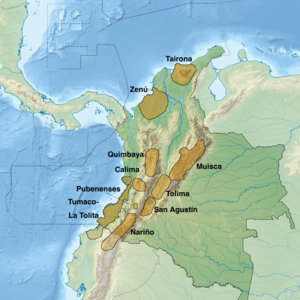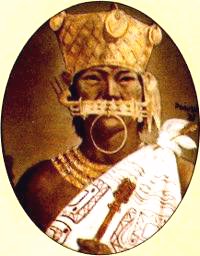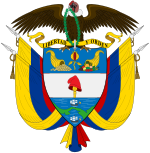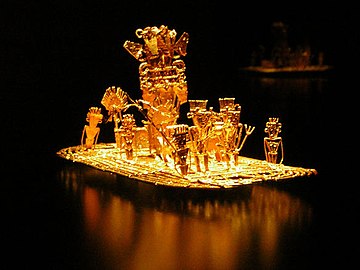History of Colombia
This article needs additional citations for verification. (February 2018) |
The history of Colombia includes its settlement by indigenous peoples and the establishment of agrarian societies, notably the
Pre-Columbian

From approximately 12.000 years
Serranía La Lindosa, a mountainous region of Guaviare Department, is known for an extensive prehistoric rock art site which stretches for nearly eight miles. The site near to the Guayabero River was discovered in 2019, but was not revealed to the public until 2020. There are tens of thousands of paintings of animals and humans created up to 12.500 BP. Images of now-extinct ice age animals, such as the mastodon, helped date the site. Other ice-age animals depicted include the palaeolama, giant sloths and ice age horses. The site has gone undiscovered because of a conflict between the government and the Farc. The remote site is a two-hour drive from San José del Guaviare, followed by a four hour trek. The site was discovered by a team from National University of Colombia, University of Antioquia and the University of Exeter as part of a project funded by European Research Council as part of the Horizon 2020 Framework Programmes for Research and Technological Development. The site is to be featured in episode 2 of the Channel 4 series, Jungle Mystery: Lost Kingdoms of the Amazon. on 12 December 2020.[4][5]
Between 5000 and 1000 BCE, hunter-gatherer tribes transitioned to agrarian societies; fixed settlements were established, and pottery appeared. Beginning in the 1st millennium BCE, groups of
- Pre-Columbian
-
Tairona figure pendants in gold.
-
Golden statuette of aQuimbaya cacique.
-
UNESCO World Heritage Site). contains the largest collection of religious monuments and megalithic sculptures in Latin America[10] and is considered the world's largest necropolis.
-
plazas. The entrance can only be accessed by a climb up some 1.200 stone steps through dense jungle.[11]
-
pre-Columbian archaeoastronomical site located on the Altiplano Cundiboyacense in the outskirts of Villa de Leyva
Spanish annexation
Pre-Columbian history

Europeans first visited the territory that became Colombia in 1499 when the first expedition of
(† 1537)
(† 1539)
The Spanish advance inland from the Caribbean coast began independently from three different directions, under
In 1549, the institution of the Spanish Royal
Gran Colombia: independence re-claimed

From then on, the long independence struggle was led mainly by Bolívar and Francisco de Paula Santander in neighboring Venezuela. Bolívar returned to New Granada only in 1819 after establishing himself as leader of the pro-independence forces in the Venezuelan llanos. From there he led an army over the Andes and captured New Granada after a quick campaign that ended at the Battle of Boyacá on August 7, 1819. (For more information. see Military career of Simón Bolívar.)
That year, the Congress of Angostura established the Republic of Gran Colombia, which included all territories under the jurisdiction of the former Viceroyalty of New Granada. Bolívar was elected the first president of Gran Colombia[15] and Santander, vice president.[16]
As the Federation of Gran Colombia was dissolved in 1830, the Department of Cundinamarca (as established in Angostura) became a new country, the Republic of New Granada.[17]
The Republic: Liberal and Conservative conflict
| History of Colombia | ||
|---|---|---|
 | ||
| Timeline | ||
|
||
|
| ||
In 1863 the name of the Republic was changed officially to "United States of Colombia," and in 1886 the country adopted its present name: "Republic of Colombia".
Two political parties grew out of conflicts between the followers of Bolívar and Santander and their political visions—the
Throughout the 19th and early 20th centuries, each party held the presidency for roughly equal periods of time. Colombia maintained a tradition of civilian government and regular, free elections. The military has seized power three times in Colombia's history: in 1830, after the dissolution of Great Colombia; again in 1854 (by General José María Melo); and from 1953 to 1957 (under General Gustavo Rojas Pinilla). Civilian rule was restored within one year in the first two instances.
Notwithstanding the country's commitment to democratic institutions, Colombia's history has also been characterized by widespread, violent conflict. Two civil wars resulted from bitter rivalry between the Conservative and Liberal parties. The
A military coup in 1953 toppled the right-wing government of Conservative Laureano Gómez and brought General Gustavo Rojas Pinilla to power. Initially, Rojas enjoyed considerable popular support, due largely to his success in reducing "La Violencia." When he did not restore democratic rule and occasionally engaged in open repression, however, he was overthrown by the military in 1957 with the backing of both political parties, and a provisional government was installed.
The National Front regime (1958–1974)
In July 1957, former Conservative President Laureano Gómez (1950–1953) and former Liberal President Alberto Lleras (1945–1946. 1958–1962) issued the "Declaration of Sitges," in which they proposed a "National Front," whereby the Liberal and Conservative parties would govern jointly. The presidency would be determined by an alternating conservative and liberal president every 4 years for 16 years; the two parties would have parity in all other elective offices.
The National Front ended "La Violencia," and National Front administrations attempted to institute far-reaching social and economic reforms in cooperation with the Alliance for Progress. In particular, the Liberal president Alberto Lleras Camargo (1958–1962) created the Colombian Institute for Agrarian Reform (INCORA), and Carlos Lleras Restrepo (1966–1970) further developed land entitlement. In 1968 and 1969 alone, the INCORA issued more than 60.000 land titles to farmers and workers.
In the end, the contradictions between each successive Liberal and Conservative administration made the results decidedly mixed. Despite the progress in certain sectors, many social and political injustices continued.
The National Front system itself eventually began to be seen as a form of political repression by dissidents and even many mainstream voters, and many protesters were victimized during this period. Especially after what was later confirmed[
Although the system established by the Sitges agreement was phased out by 1974, the 1886 Colombian constitution — in effect until 1991—required that the losing political party be given adequate and equitable participation in the government which, according to many observers and later analysis, eventually resulted in some increase in corruption and legal relaxation. The current 1991 constitution does not have that requirement, but subsequent administrations have tended to include members of opposition parties.
Post-National Front
From 1974 until 1982, different presidential administrations chose to focus on ending the persistent
By 1974, another challenge to the state's authority and legitimacy had come from
The ELN guerrilla had been seriously crippled by military operations in the region of Anorí by 1974, but it managed to reconstitute itself and escape destruction, in part due to the administration of Alfonso López Michelsen (1974–1978) allowing it to escape encirclement, hoping to initiate a peace process with the group.
By 1982, the perceived passivity of the
Citizen exhaustion due to the conflict's newfound intensity led to the election of president Belisario Betancur (1982–1986), a Conservative who won 47% of the popular vote, directed peace feelers at all the insurgents, and negotiated a 1984 cease-fire with the FARC and M-19 after a 1982 release of many guerrillas imprisoned during the previous effort to overpower them. The ELN rejected entering any negotiation and continued to recover itself through the use of extortions and threats, in particular against foreign oil companies of European and U.S. origin.
As these events were developing, the growing
The first negotiated cease-fire with the M-19 ended when the guerrillas resumed fighting in 1985, claiming that the cease-fire had not been fully respected by official security forces, saying that several of its members had suffered threats and assaults, and also questioning the government's real willingness to implement any accords. The Betancur administration, in turn, questioned the M-19's actions and its commitment to the peace process, as it continued to advance high-profile negotiations with the FARC, which led to the creation of the Patriotic Union (Colombia) (UP), a legal and non-clandestine political organization.
On November 6, 1985, the M-19 stormed the Colombian Palace of Justice and held the Supreme Court magistrates hostage, intending to put president Betancur on trial. In the ensuing crossfire that followed the military's reaction, scores of people lost their lives, as did most of the guerrillas, including several high-ranking operatives. Both sides blamed each other for the outcome.
Meanwhile, individual FARC members initially joined the UP leadership in representation of the guerrilla command, though most of the guerrilla's chiefs and militiamen did not demobilize nor disarm, as that was not a requirement of the process at that point in time. Tension soon significantly increased as both sides began to accuse each other of not respecting the cease-fire. Political violence against FARC and UP members (including presidential candidate Jaime Pardo) was blamed on drug lords and also on members of the security forces (to a much lesser degree on the argued inaction of Betancur administration). Members of the government and security authorities increasingly accused the FARC of continuing to recruit guerrillas. as well as kidnapping, extorting and politically intimidating voters even as the UP was already participating in politics.
The Virgilio Barco (1986–1990) administration, in addition to continuing to handle the difficulties of the complex negotiations with the guerrillas, also inherited a particularly chaotic confrontation against the drug lords, who were engaged in a campaign of terrorism and murder in response to government moves in favor of their extradition overseas. The UP also suffered an increasing number of losses during this term (including the assassination of presidential candidate Bernardo Jaramillo), which stemmed both from private proto-paramilitary organizations, increasingly powerful drug lords and a number of would-be paramilitary-sympathizers within the armed forces.
Post-1990
Following administrations had to contend with the guerrillas, paramilitaries, narcotics traffickers and the violence and corruption that they all perpetuated, both through force and negotiation. Narcoterrorists assassinated three presidential candidates before
The M-19 and several smaller guerrilla groups were successfully incorporated into a peace process as the 1980s ended and the 1990s began, which culminated in the elections for a Constituent Assembly of Colombia that would write a new constitution, which took effect in 1991. The new Constitution brought about a considerable number of institutional and legal reforms based on principles that the delegates considered as more modern, humanist, democratic and politically open than those in the 1886 constitution. Practical results were mixed and mingled emerged (such as the debate surrounding the constitutional prohibition of extradition, which later was reversed), but together with the reincorporation of some of the guerrilla groups to the legal political framework, the new Constitution inaugurated an era that was both a continuation and a gradual, but significant, departure from what had come before.
Contacts with the FARC, which had irregularly continued despite the generalized
President
On August 7, 1998, Andrés Pastrana was sworn in as the President of Colombia.[19] A member of the Conservative Party, Pastrana defeated Liberal Party candidate Horacio Serpa in a run-off election marked by high voter turnout and little political unrest. The new president's program was based on a commitment to bring about a peaceful resolution of Colombia's longstanding civil conflict and to cooperate fully with the United States to combat the trafficking of illegal drugs.
While early initiatives in the Colombian peace process gave reason for optimism, the Pastrana administration also has had to combat high unemployment and other economic problems, such as the fiscal deficit and the impact of global financial instability on Colombia. During his administration, unemployment has risen to over 20%. Additionally, the growing severity of countrywide guerrilla attacks by the FARC and ELN. and smaller movements, as well as the growth of drug production, corruption and the spread of even more violent paramilitary groups such as the United Self-Defense Forces of Colombia (AUC) has made it difficult to solve the country's problems.
Although the FARC and ELN accepted participation in the peace process, they did not make explicit commitments to end the conflict. The FARC suspended talks in November 2000, to protest what it called "paramilitary terrorism" but returned to the negotiating table in February 2001 following 2 days of meetings between President Pastrana and FARC leader Manuel Marulanda. The Colombian Government and ELN in early 2001 continued discussions aimed at opening a formal peace process.
From 2004 and on

By 2004, the security situation of Colombia had shown some measure of an improvement, and the economy, while still fragile, had also shown some positive signs. On the other hand, relatively little had been accomplished in structurally solving most of the country's other grave problems, in part due to legislative and political conflicts between the administration and the Colombian Congress (including those over the controversial 2006 project to give President Álvaro Uribe the right to be re-elected), and a relative lack of freely allocated funds and credits. In October 2006, Uribe was re-elected by a landslide.[20]
Some critical observers consider in retrospect that Uribe's policies, while admittedly reducing crime and guerrilla activity, were too slanted in favor of a military solution to Colombia's internal war, neglecting grave social and human rights concerns to a certain extent. They hoped that Uribe's government would make serious efforts towards improving the human rights situation inside the country, protecting civilians and reducing any abuses committed by the armed forces.
Uribe's supporters in turn believed that increased military action was a necessary prelude to any serious negotiation attempt with the guerrillas and that the increased security situation would help the government, in the long term, to focus more actively on reducing most wide-scale abuses and human rights violations on the part of both the armed groups and any rogue security forces that might have links to the paramilitaries. In short, these supporters maintained that the security situation needed to be stabilized in favor of the government before any other social concerns could take precedence. In February 2010, the constitutional court blocked President Alvaro Uribe from seeking for a new re-election.[21] Uribe left the presidency in 2010.
In 2010 Juan Manuel Santos was elected president; he was supported by ex-president Uribe, and, in fact, he owed his election mainly through having won over former Uribe supporters.[22] But two years after winning the presidential election, Santos (to widespread surprise) began peace talks with FARC. which took place in Havana.[23] Re-elected in 2014,[24] Santos revived an important infrastructure program, which in fact had been planned during the Uribe administration. Focused mainly on the provision of national highways, the program was led by former vice-president Germán Vargas Lleras.
In 2015, Colombia's Congress limited presidency to single term, preventing the president from seeking re-election.[25]
Talks between the government and the guerrillas resulted in the announcement of a peace agreement.
In May 2018,
The 19 June 2022 election run-off vote ended in a win for former guerrilla Gustavo Petro, taking 50.47% of the vote compared to 47.27% of right-wing Rodolfo Hernández. The single-term limit for the country's presidency prevented president Iván Duque from seeking re-election. Petro became the country’s first leftist president-elect. On 7 August 2022, he was sworn in.[43][44]
See also
- Colombia during World War II
- Economic history of Colombia
- History of the Americas
- History of Latin America
- History of South America
- List of presidents of Colombia
- Politics of Colombia
- Spanish colonization of the Americas
References
- ^ Correal, Urrego G. (1993). "Nuevas evidencias culturales pleistocénicas y megafauna en Colombia". Boletin de Arqueologia (8): 3–13.
- ^
Hoopes, John (1994). "Ford Revisited: A Critical Review of the Chronology and Relationships of the Earliest Ceramic Complexes in the New World, 6000–1500 B.C. (1994)". Journal of World Prehistory. 8 (1): 1–50. S2CID 161916440.
- ^ Van der Hammen, T; Correal, G (1978). "Prehistoric man on the Sabana de Bogotá: data for an ecological prehistory". Palaeogeography, Palaeoclimatology, Palaeoecology. 25 (1–2): 179–190. .
- ^ "'Sistine Chapel of the ancients' rock art discovered in remote Amazon forest". The Guardian. 2020-11-29. Retrieved 2020-11-29.
- ^ Bocanegra, Francisco (13 November 2020). "The last major global expansion of Homo sapiens sapiens was the colonisation of the Americas, an event that happened between 18,000 and 15,000 years ago". The Santo Domingo Centre of Excellence for Latin American Research. Retrieved 29 November 2020.
- ^ Ocampo López, 2007, p. 27
- ^ Broadbent, Sylvia 1965: Los Chibchas: organización socio-política. Série Latinoamericana 5. Bogotá: Facultad de Sociología, Universidad Nacional de Colombia
- ^
Álvaro Chaves Mendoza; Jorge Morales Gómez (1995). Los indios de Colombia (in Spanish). Vol. 7. Editorial Abya Yala. ISBN 9978041699.
- ^ de Mahecha, Ana María Groot (1988). "Intento de delimitación del territorio de los grupos étnicos Pastos y Quillacingas en el altiplano nariñense". Boletín de Arqueología de la Fian (in Spanish). 3 (3). Boletín de arqueología de la Fian 3.3: 3–31.
- ^ "San Agustín Archaeological Park". UNESCO World Heritage Center. Retrieved 27 January 2015.
- ^ "Explore the Site". Global Heritage Fund. Archived from the original on 2014-09-08.
- ^ Tairona Heritage Trust: Tairona history to the time of the Spanish Invasion Tairona Heritage Trust Accessed 21 August 2007.
- ^ Lonely Planet, "History of Colombia", http://www.lonelyplanet.com/colombia/history. Accessed 6 May 2013.
- S2CID 249318172.
- ^ Frittoli, Edoardo (2017-08-01). "Il Venezuela: la storia in foto dagli Spagnoli a Maduro (1498-2017) - Panorama". Panorama (in Italian). Retrieved 2018-09-04.
- ^ "Francisco de Paula Santander | Colombian statesman and soldier". Encyclopedia Britannica. Retrieved 2018-12-31.
- ^ "Viceroyalty of New Granada | historical territory, South America". Encyclopedia Britannica. Retrieved 2018-06-11.
- ISBN 9781476602936. Retrieved 30 September 2015.
- ^ Schemo, Diana Jean (8 August 1998). "Colombia Installs New President Who Plans to Talk to Rebels". The New York Times.
- ^ "Colombian President Uribe Re-elected in Landslide". VOA.
- ^ "Colombia's Uribe blocked from re-election". Reuters. 27 February 2010.
- ^ "Juan Manuel Santos wins Colombia presidential election". the Guardian. 21 June 2010.
- ^ "Colombia confirms October peace talks with FARC". France 24. 4 September 2012.
- ^ "Colombia vote: Santos re-elected as president". BBC News. 16 June 2014.
- ^ L, Elizabeth Reyes (4 June 2015). "Colombian lawmakers approve a one-term limit for presidents". EL PAÍS English Edition.
- ^ "Colombia's peace deals". altocomisionadoparalapaz.gov.co. Retrieved 6 September 2017.
- ^ "Colombia referendum: Voters reject Farc peace deal". BBC News. 3 October 2016. Retrieved 2 November 2016.
- ^ "Plebiscito 2 octubre 2016 – Boletín Nacional No. 53". Registraduría Nacional de Estado Civil. 2 October 2016. Retrieved 2 November 2016.
- ^ "Colombia signs new peace deal with Farc". BBC News. 24 November 2016.
- ^ "Colombia's congress approves historic peace deal with FARC rebels". Washington Post. 30 November 2016.
- ^ "Nobel Lecture by Juan Manuel Santos, Oslo, 10 December 2016". nobelprize.org. Retrieved 10 December 2016.
- ^ "The Victims and Land Restitution Law" (PDF) (in Spanish). unidadvictimas.gov.co. Archived from the original (PDF) on 25 September 2015. Retrieved 21 December 2014.
- ^ "the Land Restitution Unit". restituciondetierras.gov.co. Retrieved 23 March 2013.
- ^ The country has improved its political climate, public debate, in all manner of things including obviously in the subject of human rights: Human Rights Watch. colombiareports.co (12 October 2011).
- ^ "ABC Jurisdicción Especial para la Paz". Oficina del Alto Comisionado para la Paz. Retrieved 24 August 2016.
- ^ "Pope at Colombia prayer meeting for reconciliation weeps with victims". radiovaticana.va. 2017-09-08.
- ^ "Iván Duque: Colombia's new president sworn into office". BBC News. 8 August 2018.
- ^ Colombia and Venezuela restore diplomatic relations. bbc.com (11 August 2010).
- ^ "Colombia reitera ofrecimiento de ayuda humanitaria a Venezuela". presidencia.gov.co (in Spanish). 11 January 2018.
- ^ "Comunicado de prensa del Ministerio de Relaciones Exteriores". presidencia.gov.co (in Spanish). 2 June 2017.
- ^ "A Short History of the SDGS". impakter.com. 20 September 2016. Retrieved 8 October 2017.
- ^ "Colombia rejects Venezuelan proposal to resume diplomatic relations". Reuters. 30 January 2020.
- ^ "Former guerrilla Gustavo Petro wins Colombian election to become first leftist president". the Guardian. 20 June 2022.
- ^ "Ex-rebel takes oath as Colombia's first left-wing president". www.aljazeera.com.
Bibliography
- ISBN 978-958-14-0368-4.
Further reading
- Alesina, Alberto, ed. Institutional reforms: The case of Colombia (MIT press, 2005).
- Earle, Rebecca. Spain and the Independence of Colombia, 1810–1825. Exeter: University of Exeter Press, 2000. ISBN 0-85989-612-9
- Echavarría, Juan José, María Angélica Arbeláez, and Alejandro Gaviria. "Recent economic history of Colombia." in Institutional Reforms: The Case of Colombia (2005): 33-72.
- Echeverry, Juan Carlos, et al. "Oil in Colombia: history, regulation and macroeconomic impact." Documento CEDE 2008-10 (2008). online
- Etter, Andrés, Clive McAlpine, and Hugh Possingham. "Historical patterns and drivers of landscape change in Colombia since 1500: a regionalized spatial approach." Annals of the Association of American Geographers 98.1 (2008): 2-23.
- Farnsworth-Alvear, Ann. Dulcinea in the Factory: Myths, Morals, Men, and Women in Colombia's Industrial Experiment, 1905–1960. Duke University Press 2000.
- Fisher, J.R. Allan J. Kuethe, and Anthony McFarlane. Reform and Insurrection in Bourbon New Granada and Peru. Baton Rouge: Louisiana State University Press 1990.
- Flores, Thomas Edward. "Vertical inequality, land reform, and insurgency in Colombia." Peace Economics, Peace Science and Public Policy 20.1 (2014): 5-31. online
- Harvey, Robert. "Liberators: Latin America's Struggle for Independence, 1810–1830". John Murray, London (2000). ISBN 0-7195-5566-3
- Kuethe, Allan J. Military Reform and Society in New Granada, 1773–1808. Gainesville: University of Florida Press 1978.
- LeGrand, Catherine. Frontier Expansion and Peasant Protest in Colombia, 1850–1936. Albuquerque: University of New Mexico Press 1986.
- López-Pedreros, A. Ricardo. Makers of democracy: a transnational history of the middle classes in Colombia (Duke University Press, 2019).
- McFarlane, Anthony. Colombia Before Independence: Economy, Society, and Politics under Bourbon Rule. Cambridge: Cambridge University Press, 1993. ISBN 978-0-521-41641-2
- Martz, John D. The politics of clientelism in Colombia: Democracy and the state (Routledge, 2017).
- Murillo, Mario A., and Jesus Rey Avirama. Colombia and the United States: war, unrest, and destabilization (Seven Stories Press, 2004).
- Phelan, John Leddy. The People and the King: The Comunero Revolt in Colombia, 1781. Madison: University of Wisconsin Press 1978.
- Racine, Karen. "Simón Bolívar and friends: Recent biographies of independence figures in Colombia and Venezuela" History Compass 18#3 (Feb 2020) https://doi.org/10.1111/hic3.12608
- Roldán, Mary. Blood and Fire: La Violencia in Antioquia, Colombia 1946–1953. Durham: Duke University Press 2002.
- Safford, Frank. Colombia: Fragmented Land, Divided Society. New York: Oxford University Press 2002.
- Sharp, William Frederick. Slavery on the Spanish Frontier: The Colombia Chocó, 1680–1810. Norman: University of Oklahoma Press 1976.
- Thorp, Rosemary, and Francisco Durand. "8. A Historical View of Business-State Relations: Colombia, Peru, and Venezuela Compared." in Business and the state in developing countries. (Cornell University Press, 2018) pp. 216–236.
- Twinam, Ann. Miners, Merchants, and Farmers in Colonial Colombia. Austin: University of Texas Press 1983.
- West, Robert C. Colonial Placer Mining in Colombia. Baton Rouge: Louisiana State University Press 1952.
In Spanish
- Arciniegas, Germán. Los comuneros. Caracas: Bibliotecta Ayacucho 1992.
- Colmenares, Germán. Historia económica y social de Colombia, 1537–1719. Cali 1973.
- González, Margarita. El resguardo en el Nuevo Reino de Granada. 3rd edition. Bogotá: El Ancora 1992.
External links
- Latin American Network Information Center. "Colombia: History". USA: University of Texas at Austin.
- U.S. State Department Background Note: Colombia





![San Agustín Archaeological Park (UNESCO World Heritage Site). contains the largest collection of religious monuments and megalithic sculptures in Latin America[10] and is considered the world's largest necropolis.](http://upload.wikimedia.org/wikipedia/commons/thumb/4/4c/Parque_Arqueol%C3%B3gico_de_San_Agust%C3%ADn_-_tomb_of_a_deity_with_supporting_warriors.jpg/407px-Parque_Arqueol%C3%B3gico_de_San_Agust%C3%ADn_-_tomb_of_a_deity_with_supporting_warriors.jpg)
![Ciudad Perdida is a major settlement believed to have been founded around 800 CE. It consists of a series of 169 terraces carved into the mountainside. a net of tiled roads and several small circular plazas. The entrance can only be accessed by a climb up some 1.200 stone steps through dense jungle.[11]](http://upload.wikimedia.org/wikipedia/commons/thumb/0/0e/Lost_City_Ruins.jpg/482px-Lost_City_Ruins.jpg)







